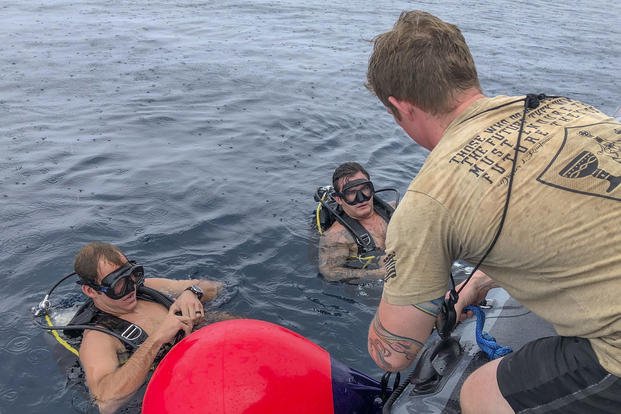U.S. Navy Explosive Ordnance Disposal (EOD) sailors could see more money from special pays and bonuses under a new vision to prepare the specialized force for large-scale naval warfare.
Navy officials on Wednesday unveiled the new Navy Explosive Ordnance Disposal Strategic Vision 2030, a plan designed to use the lessons of operations in Iraq and Afghanistan to counter the much larger, more sophisticated weapons available to a major adversary such as Russia or China.
"What makes this unique for Navy EOD is that the last time the Navy EOD community put out a strategic vision was in March of 1997," Capt. Oscar Rojas, commodore of Explosive Ordnance Disposal Group One, told defense reporters at the Pentagon. "A lot of things have happened since March of 1997 to include Sept. 11, 2001, and 17 years of combat operations that have forced our community ... to evolve."
Under the new vision, Navy EOD units will focus more on forensic analysis in the weapons of mass destruction mission, a skill honed in the mission in Iraq and Afghanistan to defeat improvised explosive devices, said Capt. Rick Hayes, commodore of Explosive Ordnance Disposal Group Two.
"As our folks rendered IEDs safe on the battlefield, we helped trace back the construction of those devices to particular bomb makers and builders and emplacers to get after the threat, and that is an area of growth for us," he said.
Navy EOD units will also place a greater emphasis on using unmanned systems in the counter-mine mission, Rojas said.
"The future of warfare is about drones and robots, and we, the Navy EOD community, are taking unmanned systems to be able to get after those threats, not only on the ground, but on the surface and sub-surface," he said.
To help achieve the new vision, EOD officials are looking at new ways to compensate sailors who choose to this dangerous work as a long-term career path.
"We are looking at special pays and bonuses," Rojas said. "What gives Navy EOD a competitive advantage against an adversary is our sailors. They are our weapon system, so we have to invest in our weapon systems -- our sailors -- in order to remain on top."
Senior Navy leaders are also considering a promotion policy designed to fill vacancies as needed, he said.
"If there are vacancies for a certain paygrade, one of our sailors could apply for that job and get promoted to go fill that job because they are ready for that next career milestone," Rojas said. "Potentially, the EOD community will be one of the first communities that will get to test that concept out."
In addition to critical-skill retention bonuses, "we are looking at combining certain special pays into one much larger special pay; that is one way to help with retention," Rojas said.
Navy EOD is an "extremely small community," made up about 460 officers and 1,200 enlisted, as well as roughly 300 hundred support personnel, on the East and West coasts, Hayes said.
"Many of them stay in for the job and the love of the community, but we are going to do everything we can to make sure that they are properly compensated for the work that they are doing," he said.
-- Matthew Cox can be reached at matthew.cox@military.com.
Read more: New Commissary, Exchange Access Delayed for Many Veterans














